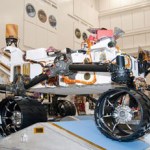Cosmos
By Dr. Rosalba Bonaccorsi
Environmental Scientist at the Carl Sagan Center for the Study of Life in the Universe, SETI Institute, and Gail Jacobs
Rosalba, what first sparked your interest in science?
I've always had big dreams -- even as a young girl. As soon as I started to walk, I took an interest in conducting experiments with whatever was available around such as household plants and various chemical compounds. I'm lucky I didn't end up poisoned or otherwise hurt! I remember dismantling alarm clocks. I was so curious!
As a young girl, I was in poor health and as a result spent a lot of…
NASA has slyly, or inadvertantly, let out a handful of clues that a planned news conference will reveal details of an important new finding regarding life on other planets. There have been a number of moments in the history of astrobiology where an important find has gotten us all very excited, including the discovery of isotopic profiles on a Mars rock (a meteorite) indicating a biological pathway, parallel findings on Mars, various discoveries related to water on Mars, and analysis of places like Europa and Titan, and so on. The word on the street is that this is going to be one such…
click image to make it gigantic
This false-color composite image, constructed from data obtained by NASA's Cassini spacecraft, shows Saturn's rings and southern hemisphere. The composite image was made from 65 individual observations by Cassini's visual and infrared mapping spectrometer in the near-infrared portion of the light spectrum on Nov. 1, 2008. The observations were each six minutes long.
In this image constructed from data collected in the near-infrared wavelengths of light, scientists designated blue to indicate sunlight reflected at a wavelength of 2 microns, green to indicate…
"The brown dwarfs jump out at you like big, fat, green emeralds," said Amy Mainzer, the deputy project scientist of WISE at NASA's Jet Propulsion Laboratory in Pasadena, Calif. Mainzer, who makes jewelry in her spare time, explained that the brown dwarfs appear like green gems in WISE images because the methane in their atmospheres absorbs the infrared light that has been coded blue, and because they are too faint to give off the infrared light that is color-coded red. The only color left is green.
Like Jupiter, brown dwarfs are made up of gas -- a lot of it in the form of methane, hydrogen…
After extracting the final proton beam of 2010 on 4 November, commissioning the lead-ion beam was underway by early afternoon. First collisions were recorded at 00:30 CET on 7 November, and stable running conditions marked the start of physics with heavy ions at 11:20 CET today.
...
Operating the LHC with lead ions - lead atoms stripped of electrons - is completely different from operating the machine with protons. From the source to collisions, operational parameters have to be re-established for the new type of beam. For lead-ions, as for protons before them, the procedure started with…
View image
The gullies on a Martian sand dune in this trio of images from NASA's Mars Reconnaissance Orbiter deceptively resemble features on Earth that are carved by streams of water. However, these gullies likely owe their existence to entirely different geological processes apparently related to the winter buildup of carbon-dioxide frost.
Scientists at the University of Arizona, Tucson, and at Johns Hopkins University Applied Physics Laboratory, Laurel, Md., compared pairs of images from before and after changes in such dune gullies. They determined that the changes occur in Martian…
The Mars Rover Spirit got stuck, probably forever, last year, but the little guy has not given up doing science!!!!
The extraterrestrial vehicle discovered evidence "that water, perhaps as snow melt, trickled into the subsurface fairly recently and on a continuing basis."
Oh, great, mud! That's going to make it easy to get unstuck...
Here, look:
View image
Soil Disturbed by Spirit Before Fourth Martian Winter
This mosaic of images shows the soil in front of NASA's Mars Exploration Rover Spirit after a series of short backward drives during attempts to extricate the rover from a sand trap in…
... maybe....
Not in a black hole, where it is supposed to constitute the 'evaporation' of photons across the hole's event horizon, but rather, in a refractive index perturbation style event horizon, in the lab. It is made in glass.
... researchers using a CCD camera detected a peculiar kind of photon emission at a 90-degree angle to the glass. ... researchers arranged the experiment in a way to strongly suppress or eliminate other types of radiation.
"Experimental evidence of photon emission that on one hand bears the characteristics of Hawking radiation and on the other is distinguishable…
By Dr. Paul EstradaPlanetary physicist at the Carl Sagan Center for the Study of Life in the Universe, SETI Institute, and Gail Jacobs
If planets are a dime a dozen, moons are less than a penny each. There are at least 139 moons just within our own solar system. Most of these are the property of the gas giant planets beyond Mars. More than just a nice accompaniment to planets, moons may have habitats in which liquid water could ebb and flow - and possibly be a suitable home for life. Planetary physicist Dr. Paul Estrada investigates how moons around gas giants are formed -- an important…
A collection of meteor videos for your amusement and amazement:
Peekskill Bolide Fireball of 1992
Police dash cam of Meteor over Edmonton, Canada
Man hit by meteor (very rare footage)
Shower of comets right above some guy's apartment in North Carolina
Five state ongoing intermittent noisy meteor shower
Absolute proof that aliens are protecting us .... or perhaps saving us for later:
2006 Mexico
Blaire Witch Meteor
By Dr. Mark R. Showalter
Planetary astronomer at the Carl Sagan Center for the Study of Life in the Universe, SETI Institute
It was just a few months ago that Stephen Hawking was making headlines with his bold assertion that extraterrestrial beings, if they exist, are best avoided. His argument was based in part upon the fact that the arrival of Christopher Columbus to the "New World" didn't work out so well for the Native Americans who were already here. However, upon closer inspection, Hawking's ideas fell apart. Even if nomadic tribes of ETs are really out there looking for a handy source…
By now, this news is a few days old, but there was something I wanted to check on before noting it. Here's the story:
NASA's Kepler spacecraft has discovered the first confirmed planetary system with more than one planet crossing in front of, or transiting, the same star.
The transit signatures of two distinct planets were seen in the data for the sun-like star designated Kepler-9. The planets were named Kepler-9b and 9c. The discovery incorporates seven months of observations of more than 156,000 stars as part of an ongoing search for Earth-sized planets outside our solar system. The…
Then I saw this:
Courtesy oif Dynamics of Cats:
If you have any questions about this, don't ask me, as him.
Did you know that galaxies can die? They are apparently declared dead by astronomers when they stop making new stars. But a recent finding suggests that this kind of death is not the end of the road for at least some galaxies.
Astronomers have found mysterious, giant loops of ultraviolet light in aged, massive galaxies, which seem to have a second lease on life. Somehow these "over-the-hill galaxies" have been infused with fresh gas to form new stars that power these truly gargantuan rings, some of which could encircle several Milky Way galaxies.
The discovery of these rings implies that…
Astronomer Dimitar Sasselov and his colleagues search for Earth-like planets that may, someday, help us answer centuries-old questions about the origin and existence of biological life elsewhere (and on Earth). How many such planets have they found already? Several hundreds.
The Rover Spirit is hibernating on a dark slope on the winter end of the planet Mars. Solar panels may be providing enough energy to keep its clock going. If not, it will become suspended in time and not know to wake up and send a signal that it is 'alive.' The panels may or may not keep the battery temperatures above 40 degrees below zero Celsius so that batteries survive the Martian winter, which is said to be almost as bad as the Minnesota winter. But probably not. And for now, the mission controllers are waiting for a beep that could come any time.
The earliest date the rover could…
If you do, now is when you should do something about it. The Planetary Society is asking for Americans to contact their Senators, RIGHT NOW.
It's time to make phone calls to support space exploration. We're sending the following letter to all our members today, and urge everyone reading this to pick up the phone and take action. I've already made my phone calls.
The NASA budget is coming to a critical vote tomorrow, July 15, by the U.S. Senate Committee on Commerce, Science, and Transportation. This is the Committee that authorizes the NASA program. The planned authorization bill has some…
This is Lutetia, as photographed by the European Space Agency's Rosetta Probe. Details.
Well, it is. But the Proton "got smaller" just now. And, by "got smaller" I mean that the accepted measurement of the proton has been adjusted slightly. The new measurement for the proton's diameter is about 0.00000000000003 mm (0.03 femtometers less than it was before. This is important:
"It's a very serious discrepancy," says Ingo Sick, a physicist at the University of Basel in Switzerland, who has tried to reconcile the finding with four decades of previous measurements. "There is really something seriously wrong someplace."
The difference between the old and new measurement is…
It must have been very difficult to get the Universe to stand still for this photograph, but the European Space Agency managed it . Check it out.
Here is a web site that shows you what the sky looks like when viewed in different wavelengths, or using different energy sources.

